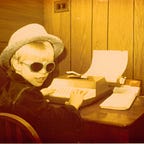‘Sting-Ray’ and the ’70s
This year, I made one simple New Year’s resolution: to read and write more. So, in order to combine the two, I’m going to try to write about what I read.
First up was a pair of memoirs: one by Dick Portillo, the hot dog hero behind my favorite Chicago eatery, the eponymous Portillo’s (“Out of the Dog House”); and the other by Steve Rushin, the brilliantly clever sportswriter (“Sting-Ray Afternoons”). I began reading them concurrently, but completed Rushin’s book first because I could barely put it down.
“Sting-Ray Afternoons” (2017) is Rushin’s nostalgic look at his childhood years, growing up in the 1970s in Bloomington, Minn. Rushin is 4 years older than me and grew up in the suburbs of Minneapolis, rather than the suburbs of Chicago. He grew up in a town that also was home to actual professional sports teams — with the impressive newspaper dateline, to boot — and then he actually worked at Metropolitan Stadium — a dream for any sports-obsessed kid. I did neither.
Nevertheless, save for the proximity to pro sports and the family dynamics, Rushin’s story of growing up in the ’70s could be mine — or any young boy of that decade.
There is one striking, exact similarity, though: Rushin was born in the Chicago suburbs and lived in Lisle, Ill., until he was almost 3 before moving to Bloomington. I also lived in Lisle until I was 3, before moving to a different Chicago ’burb. My father taught English at Lisle High for 37 years and worked for the Lisle Park District, so many, many of my own memories of the ’70s occurred in Lisle.
The enduring memories of all ’70s kids, of course, revolve around the pop culture, and here Rushin touches all the bases: the TV shows (“Charlie’s Angels”), the movies (“Jaws”), the music (“Hotel California”), the toys, the sneakers, the commercials, the made-up sports games, the news events (Watergate), the sayings, the fart jokes, and even the ubiquitous everyday items, such as BIC Cristal pens. “Sting-Ray Afternoons” is like a time capsule, transporting us Gen Xers back to a seemingly simpler time.
Rushin not only recounts in impeccable detail the specifics of his childhood, starting with the family’s move from Lisle to Bloomington — literally while Armstrong and Aldrin walked on the moon — but he also delves into some of the history of the products and companies that helped define the decade: Nerf footballs, Romper Stompers, the Sears Christmas Wish Book, Motorola’s car radio, the 747, the aforementioned BIC Cristal pens (with the blue cap and the little blue plug, perfect for spitballs), and, of course, Schwinn’s Sting-Ray bicycle. All those history lessons are compelling and help illuminate the era.
Few writers can turn a phrase like Rushin, and it’s fascinating now to see where his love of words and wordplay originated. From his earliest days, he was drawn to the magic of words, which only makes his storytelling that much more engaging. I truly enjoyed his prose and also his use of present tense, putting the reader in the memorable moments of his childhood. (I also relished his penchant for punctuation; he describes his dad, who sold Scotch brand recording tape for 3M, as “a magnetic-tape salesman, who is also a magnetic tape salesman — behold, the power of the hyphen!”)
Besides the memories and the writing, Rushin’s book left me in awe in another way — not only of his work, but also of his career. To grow up in the ’70s in the shadow of “the Met” and become a celebrated and accomplished sportswriter at Sports Illustrated is one thing. But to return to the Twin Cities to cover the Twins winning the 1991 World Series and literally return to his childhood home that night to write about Game 7 for SI … wow, just wow.
Above all else, “Sting-Ray Afternoon” reads like a love story — love of the ’70s, love of childhood, love of his hometown, and, most of all, love and appreciation for his parents.
Rushin’s descriptions and admiration of his father, Don, in particular, paint a picture of a man so focused on giving his family more than he had — not just above his own wants but completely in lieu of them. Rushin’s memoir not only made me pine for my own ’70s upbringing, but it also made me — as a 48-year-old father with two children, including a 9-year-old son — aspire to be a better father.
I was fortunate to have my own supportive father, who busted his butt to provide me, my sister and my mother all those ubiquitous ’70s items and such wonderful experiences and memories of my first decade. Don Rushin traveled the world, selling magnetic tape; Rick Beato stayed in Lisle, teaching and mentoring high school students and athletes. Both made life swell for their sons.
Reading about another ’70s-era father who devoted his life to his family was particularly uplifting and inspiring — as is “Sting-Ray Afternoons.”
Thanks, Steve, for the memories.
